The beef caldereta recipe is a Filipino classic that’s found its way into countless family gatherings, fiestas, and weeknight dinners across the globe. Rich, savory, and deeply satisfying, this dish brings together tender beef, vegetables, and a tomato-based sauce often kicked up with liver spread, cheese, or spicy chilies. If you’ve ever tasted caldereta, you already know it’s comfort food with serious flavor. And if you haven’t? Well, you’re in for a delicious ride.
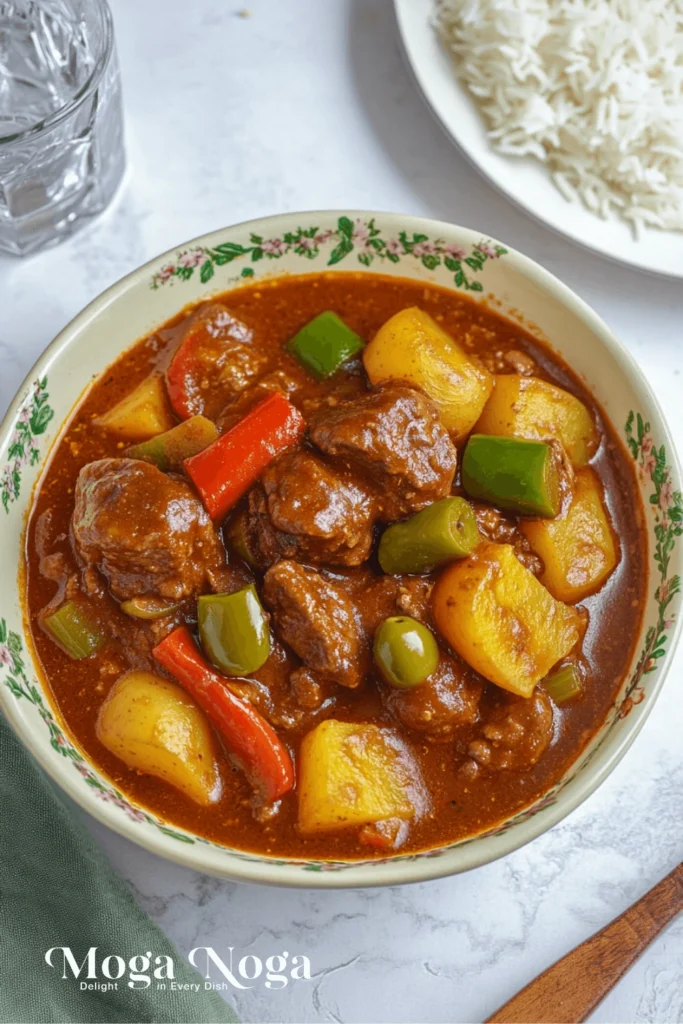
In this article, we’ll dive deep into everything you need to know about making your beef caldereta recipe at home—from the essential ingredients and cooking techniques to helpful tips, variations, and the best ways to serve it. Whether new to Filipino cuisine or looking to perfect your family’s version, you’ll walk away with everything you need to master this iconic dish.
Table of Contents
Why You’ll Love This Recipe
There’s something universally appealing about beef stews; beef caldereta takes it up a notch. Here’s why this recipe deserves a spot in your regular cooking rotation:
First off, it’s incredibly flavorful. The combination of slow-cooked beef and a sauce rich with tomato, garlic, and liver spread gives caldereta its unmistakable depth. It’s one of those dishes that tastes even better the next day—perfect for leftovers, meal prep, or feeding a crowd.
Second, it’s flexible. You can adjust the spice, swap ingredients based on what’s in your pantry, and even make it budget-friendly by using different cuts of meat or adding more veggies.
Finally, this dish tells a story. It reflects Spanish and Filipino influences, with roots in traditional Iberian stews and a tropical twist that speaks to Filipino creativity. Cooking feels like keeping a culinary tradition alive.
Plus, it’s a real crowd-pleaser. Serve this at any party, potluck, or dinner with friends; someone will ask for the guaranteed recipe.
Detailed Ingredients and Instructions
Before we get to the actual cooking process, let’s talk about what makes each ingredient in this beef caldereta recipe so important.
Ingredients:
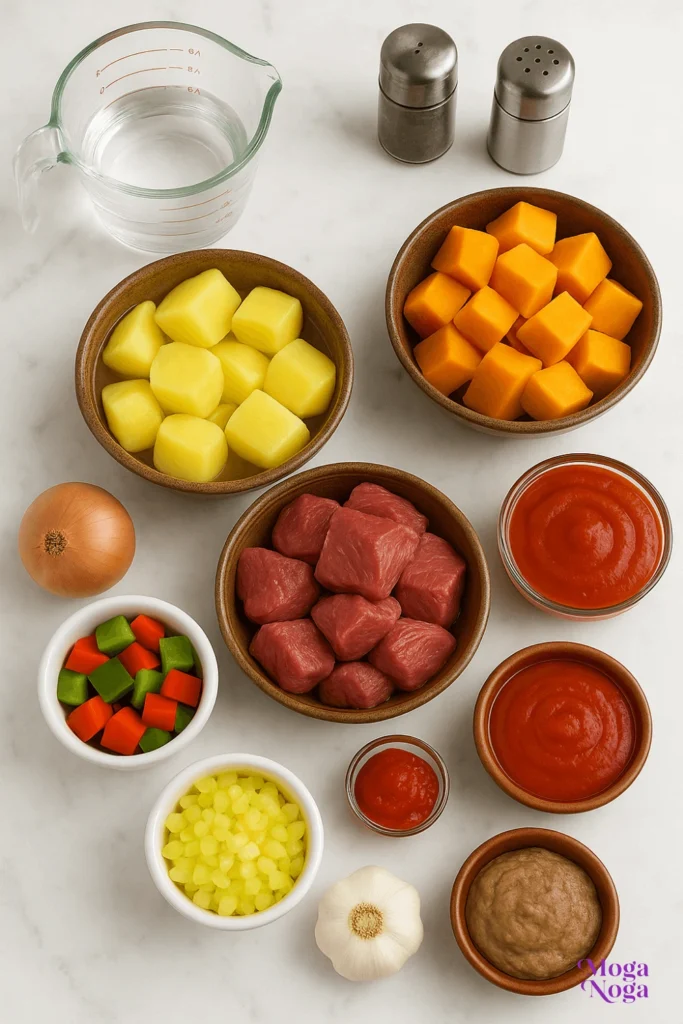
Beef – Choose a cut that holds up to slow cooking, like a chuck or brisket. These cuts become tender and flavorful after simmering for a couple of hours.
Tomato Sauce – This forms the base of the caldera sauce. It adds acidity, color, and depth. Some cooks like to use fresh tomatoes, but canned tomato sauce is more common and reliable.
Liver Spread – This might sound unusual to some, but it’s the secret weapon. It thickens the sauce and adds a creamy, slightly earthy flavor.
Potatoes and Carrots – These vegetables soak up the sauce and add natural sweetness and heartiness.
Bell Peppers – Typically added toward the end to preserve their crunch and vibrant color. They balance the richness with a bit of brightness.
Cheese is not always traditional, but many home cooks add a small amount to enrich the sauce. If you’re not a fan, you can skip it.
Chilies – Optional, but recommended if you like a bit of heat. To customize the spice level, you can use fresh siling labuyo (bird’s eye chilies), red chili flakes, or hot sauce.
Olives and Pickles – Some versions include green olives or pickles for a briny kick. This isn’t essential but can elevate the dish.
Instructions:
When it comes to instructions, here’s the basic process, broken down:
Start by browning your beef. This step locks in flavor and gives the dish a deep, savory foundation. Then, you sauté your garlic and onions in the same pot, making them soft and aromatic.
Next, add tomato sauce and cook with the beef for a few minutes. This helps everything come together and start developing flavor. Then comes the slow simmer—add your water or broth, liver spread, and let the beef cook until it’s fork-tender.
Once your beef is tender, you can toss the potatoes and carrots, followed by the bell peppers toward the end. Stir in cheese if you’re using it, and season to taste.
Simple but packed with layers of flavor and texture. Once you try it, you’ll understand why it’s such a beloved Filipino comfort food.
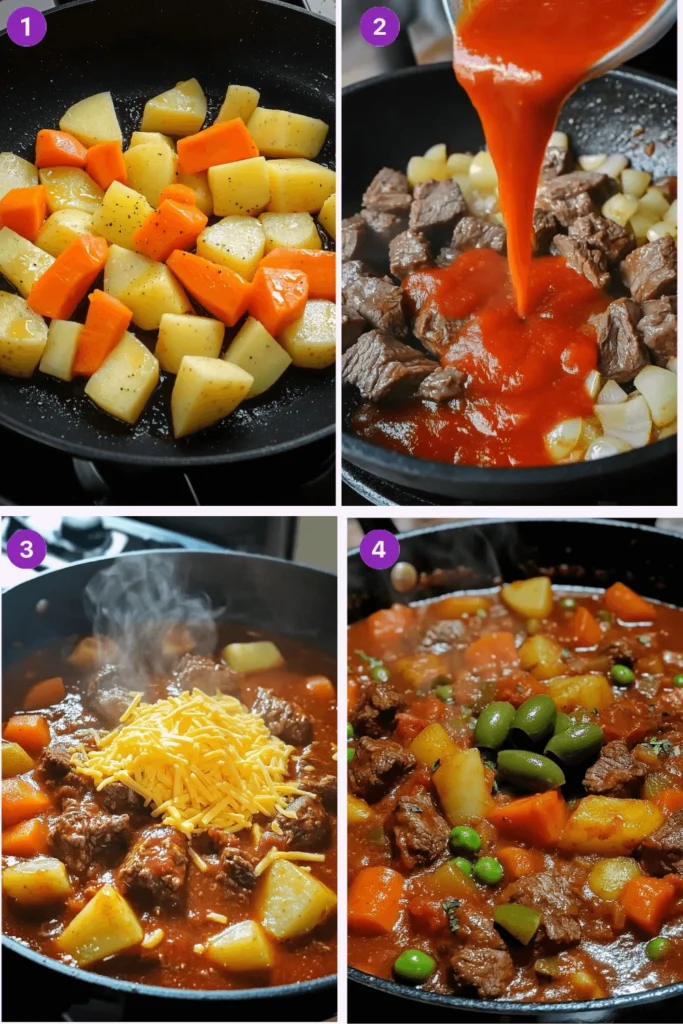
Tips, Variations, and Storage Options
Even though this beef caldereta recipe is pretty straightforward, a few minor tweaks can make a big difference. Whether you’re cooking for the first time or already have a version you love, here are some tips to improve and customize your dish.
Tips for Best Results:
- Brown your beef well. Don’t rush this step. Let the meat sit undisturbed in the pan to develop a crust. That caramelization builds a deep, meaty flavor.
- Simmer low and slow. This dish isn’t about speed. The longer you simmer it gently, the more tender your beef will be.
- Taste and adjust. Caldereta is all about balance—sweetness from the carrots, richness from the liver spread, and acidity from the tomatoes. Tweak the seasoning near the end for the best results.
- Don’t overcook the veggies. Potatoes and carrots should be tender, not mushy. Add them only after the beef is mostly cooked through.
Variations to Try:
- Go spicy. If you like heat, amp it up with bird’s eye chilies or a splash of chili oil. You can even blend in spicy liver spread or add spicy pickles.
- Swap the protein. Are you not a beef fan? Try chicken or pork caldereta. The method stays the same, but the cooking time may vary depending on your protein.
- Add olives or green peas. Some families swear by adding green olives or canned peas toward the end. These add bursts of briny or sweet flavor that complement the richness.
- Go cheesy. Caldereta with cheese isn’t strictly traditional, but it’s become popular. Grated cheddar or processed cheese (like Eden or Velveeta) gives it a creamy texture and a mellow finish.
Storage and Make-Ahead Tips:
This dish is better the next day. Store leftovers in an airtight container in the fridge for up to four days. The flavors deepen over time, and the sauce thickens beautifully.
You can also freeze beef caldereta. Let it cool completely before transferring it to freezer-safe containers or resealable bags. It’ll keep for up to two months. Thaw overnight in the fridge and reheat on the stove over low heat, adding a splash of broth or water to loosen the sauce if needed.
Equipment Needed
You don’t need anything fancy to pull off a delicious beef caldereta recipe. Just a few reliable tools:
- Heavy-bottomed pot or Dutch oven: This helps distribute heat evenly and prevents burning during the long simmer.
- Cutting board and sharp knife: Prep is smoother and safer when working with good tools.
- Wooden spoon or spatula: For stirring without scratching your pot.
- Measuring cups and spoons: Helps keep your proportions accurate.
- Serving ladle: For scooping and serving the perfect portions of that rich, saucy stew.
If you have a pressure cooker or Instant Pot, that’s also an excellent alternative for shortening the cooking time. Just adjust the liquid levels accordingly.
Related Recipes
If this beef caldereta recipe has you excited about Filipino cooking, here are some other dishes you might want to try:
- Chicken Afritada – A tomato-based stew made with chicken, potatoes, and bell peppers. It’s slightly lighter than Caldereta but still loaded with flavor.
- Pork Menudo – Another Filipino stew, menudo uses diced pork, liver, and vegetables in a slightly sweeter tomato sauce.
- Kare-Kare – A peanut-based oxtail stew often served with bagoong (fermented shrimp paste). It’s rich and comforting, with a different flavor profile.
- Adobo – The national dish of the Philippines, adobo can be made with pork, chicken, or beef simmered in vinegar, soy sauce, and garlic.
- Bistek Tagalog – Filipino-style beef steak, often cooked with onions and served with rice.
- Filipino Beef Caldereta — A bold and comforting stew made with tender beef simmered in a rich tomato sauce, flavored with liver spread, vegetables, and optional cheese. It’s a savory-sweet dish rooted in tradition, known for its deep flavor and home-cooked warmth.
All of these dishes use familiar ingredients but offer their unique textures and flavors. Once you’ve mastered caldereta, exploring the rest of the cuisine becomes even more exciting.
Pairing/Serving Suggestions
The beef caldereta recipe is hearty, but you can always take things further with a few bright pairings.
- Serve it with rice. This is the traditional—and best—way to enjoy caldera. The sauce is rich and bold, so you’ll want plain steamed rice to soak it all up.
- Try it with pandesal. These soft, slightly sweet Filipino bread rolls are perfect for dipping in the sauce.
- Offer a side salad. A fresh cucumber and tomato salad with a light vinegar dressing can help cut through the richness.
- Pair with drinks. A light lager or crisp white wine (like Sauvignon Blanc) works well with caldera. If you’re skipping alcohol, try a citrusy soda or calamansi juice for brightness.
- Finish with dessert. Filipino sweets like leche flan, halo-halo, or ube ice cream add a fun ending to the meal and round out the experience.
This dish also holds up well at room temperature, making it an excellent option for buffets or gatherings where guests might serve themselves throughout the day.
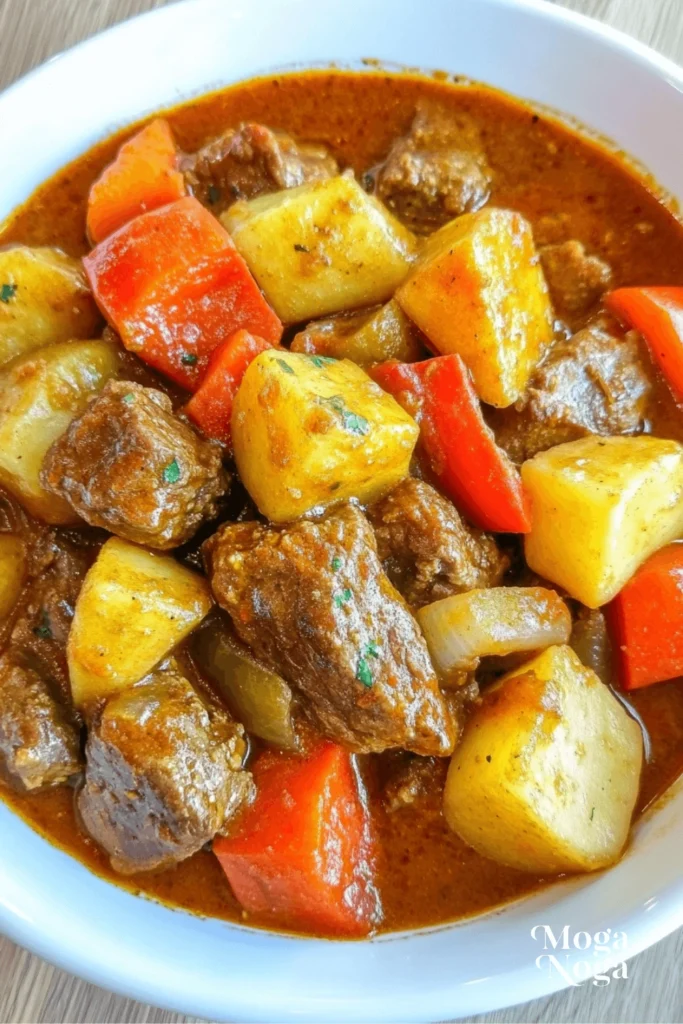
Frequently Asked Questions
Can I make this beef caldereta recipe without liver spread?
Yes, you can. While liver spread adds a distinct richness and depth to the sauce, it’s not essential. If you’re up for it, you can substitute it with pâté or a bit of mashed liver. Otherwise, skip it—your caldereta will still taste great, though a little less creamy and complex.
What’s the best cut of beef for caldera?
Chuck roast is the most popular choice because it becomes tender and flavorful when simmered. You can also use beef brisket or short ribs. Avoid lean cuts like sirloin, which can dry out and turn chewy.
Can I use a pressure cooker or Instant Pot?
Absolutely. Using a pressure cooker can cut your cooking time by more than half. Just be sure not to overcook the vegetables—add them after depressurizing and simmer for a few extra minutes.
How can I make it healthier?
Reduce the oil, skip the cheese, and add more vegetables like green beans or peas to lighten up the recipe. You can also use leaner cuts of beef or substitute with chicken.
What if I don’t eat beef?
No problem. Pork, chicken, and even tofu work well in caldereta. Just adjust your cooking times. The chicken cooks the fastest, while pork shoulder may need slightly more time to get tender.
Can I prep this ahead of time?
Yes! Caldereta is a great make-ahead dish. It usually tastes better the next day after the flavors have developed. Cook it a day in advance and reheat it before serving.
Why does my caldereta taste too sour or acidic?
That can happen if there’s too much tomato sauce or the beef hasn’t simmered long enough to mellow the acidity. Add a small pinch of sugar to balance the flavors, or stir in more liver spread or cheese to round it out.
Nutrition Information
Here’s an approximate breakdown of the nutrition per serving of this beef caldereta recipe. This is based on a standard portion with rice, using beef chuck and including liver spread and cheese:
• Calories: ~470
• Protein: ~30 grams
• Carbohydrates: ~20 grams
• Fat: ~30 grams
• Fiber: ~3 grams
• Sugar: ~5 grams
• Sodium: Varies depending on seasoning and processed ingredients
Note: These numbers can vary widely based on the exact ingredients and portion sizes you use. Reduce the oil and cheese or add more vegetables to lighten it up.
This hearty meal provides a solid source of protein and energy. If you’re watching your fat intake, consider trimming the beef or using a leaner cut.
Seasonal and Occasion Variations
The beauty of the beef caldereta recipe is that it adapts well to any time of year and nearly every occasion. Here’s how you can adjust it for different seasons and celebrations:
- Holiday Edition: Add more luxury to the dish using bone-in beef short ribs or oxtail. Stir in red wine during the simmering phase to deepen the flavor, and garnish with olives and fresh herbs. Serve it as a star dish on Noche Buena or Christmas Day.
- Summer Take: Keep it light and fresh by reducing the richness—skip the cheese and liver spread, and add more vegetables like green beans or zucchini. Pair it with a fresh salad and citrusy drinks.
- Fiesta Style: Make a big batch with many potatoes and carrots to stretch the servings. Include sliced hotdogs (a festive Filipino twist), and serve it buffet-style with heaps of rice and sides.
- Rainy Day Comfort: Go full-on cozy. Use extra cheese and chili oil for that creamy, spicy richness. Serve hot with garlic fried rice and a warm drink—perfect for monsoon or cold weather days.
- Birthday Party Favorite: Kids love it with a touch of sweetness, so some cooks add a bit of banana ketchup or pineapple juice for a kid-friendly twist. Keep the spice mild, and serve with spaghetti or bread rolls.
Whether cooking for a casual dinner or a big family event, you can always tweak caldereta to fit the vibe and the season.
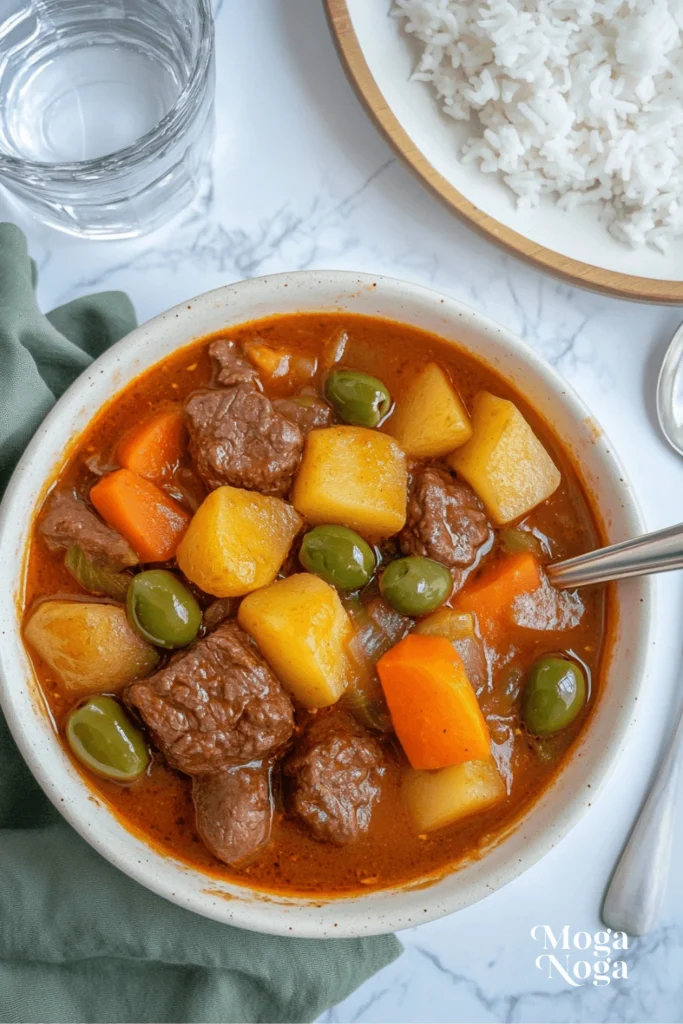
My Recipe Tips
Here are my go-to tricks for making the beef caldereta recipe come out great every single time:
• Use quality beef. Don’t settle for meat that’s too lean or tough. Fat equals flavor, and well-marbled cuts deliver better texture after a slow cook.
• Deglaze the pot. After browning the meat, use a splash of broth or water to loosen the browned bits stuck to the bottom. That’s flavor gold.
• Let the sauce reduce. If your caldereta looks watery, just let it simmer a bit longer uncovered. You want it thick and silky, not soupy.
• Don’t add all the salt early. Some ingredients (like cheese and liver spread) are salty. Season gradually and taste as you go.
• Make it your own. Filipino home cooking is about tradition but also about tweaking based on what’s available. Don’t be afraid to personalize.
This dish rewards patience, creativity, and a little bit of boldness. Once you’ve made it once or twice, you’ll find your rhythm and flavor preferences.
Conclusion
Beef caldereta isn’t just a meal—it’s a shared experience. It’s the dish that shows up when families gather, when friends reunite, and when you need something warm, filling, and deeply satisfying on the table. Whether it’s your first time trying this beef caldereta recipe or you’re fine-tuning a version passed down through generations, what matters most is how it brings people together.
The great thing about this dish is its flexibility. You can cook it slowly on a quiet weekend or make a quicker version on weeknight. You can make it as rich or as light as you like. You can go spicy or mild, cheesy or classic. However you choose to make it, caldereta rewards the cook with flavor, comfort, and plenty of opportunities to put your stamp on it.
If you loved this recipe, explore more Filipino dishes—it’s filled with bold flavors, cozy comfort food, and dishes that always feel like a celebration. Thanks for following along—and happy cooking!
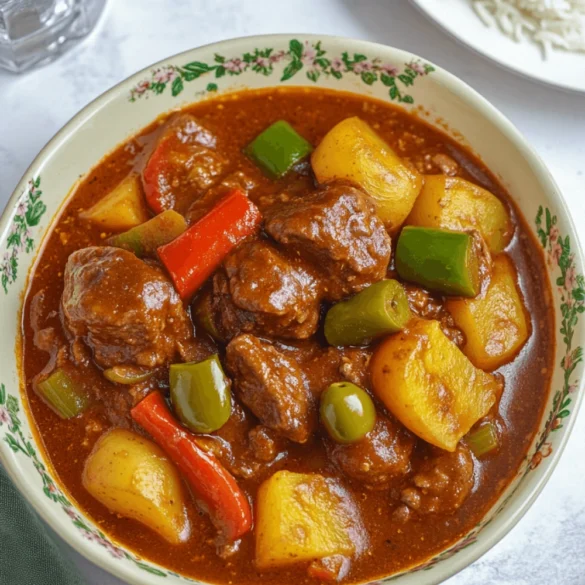
🍖 Beef Caldereta 🍅🥘
Ingredients
2 lbs beef chuck or stew meat, cut into cubes
2 tablespoons vegetable oil
1 large onion, chopped
4 cloves garlic, minced
1 large carrot, sliced
1 large potato, peeled and diced
1 red bell pepper, chopped
1 can (8 oz) tomato sauce
1/2 cup beef broth or water
1/4 cup soy sauce
2 tablespoons fish sauce (optional)
2 tablespoons tomato paste
1/4 cup peanut butter (adds richness)
1/2 cup green olives, pitted and sliced
1 teaspoon dried oregano
1 bay leaf
1/2 teaspoon black pepper
Salt to taste
1/4 cup cooking cream or heavy cream (optional, for creaminess)
Instructions
Brown the beef: In a large pot or Dutch oven, heat the vegetable oil over medium-high heat. Add the beef cubes in batches, browning them on all sides. Once browned, remove the beef and set it aside.
Sauté the vegetables: In the same pot, add a little more oil if needed. Add the onion and garlic, sautéing for 2-3 minutes until fragrant and softened. Add the carrots, potatoes, and bell pepper, and cook for an additional 5 minutes, stirring occasionally.
Add liquids and seasonings: Return the browned beef to the pot. Stir in the tomato sauce, beef broth, soy sauce, fish sauce (if using), and tomato paste. Add the peanut butter, green olives, oregano, bay leaf, and black pepper. Stir to combine.
Simmer the stew: Bring the mixture to a boil, then reduce the heat to low. Cover the pot and simmer for 1 1/2 to 2 hours, or until the beef is tender and the sauce has thickened. Stir occasionally and add more broth or water if needed.
Finish the dish: If you'd like a creamier sauce, stir in the cooking cream or heavy cream in the last 10 minutes of cooking. Taste and adjust the seasoning with salt and pepper.
Serve: Once the beef is tender and the flavors are well blended, remove the bay leaf and serve the Beef Caldereta with steamed rice.

